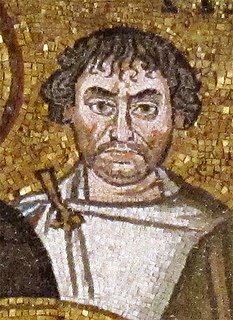
Year 552 (DLII) was a leap year starting on Monday of the Julian calendar. The denomination 552 for this year has been used since the early medieval period, when the Anno Domini calendar era became the prevalent method in Europe for naming years.
Year 551 (DLI) was a common year starting on Sunday of the Julian calendar. The denomination 551 for this year has been used since the early medieval period, when the Anno Domini calendar era became the prevalent method in Europe for naming years.

Narses was, with Belisarius, one of the great generals in the service of the Byzantine Emperor Justinian I during the Roman reconquest that took place during Justinian's reign. Narses was a Romanized Armenian. He spent most of his life as an important eunuch in the palace of the emperors in Constantinople.
Pope John III, born Catelinus, was the bishop of Rome from 17 July 561 to his death.

Delia Ann Derbyshire was an English musician and composer of electronic music. She carried out pioneering work with the BBC Radiophonic Workshop during the 1960s, including her electronic arrangement of the theme music to the British science-fiction television series Doctor Who. She has been referred to as "the unsung heroine of British electronic music", having influenced musicians including Aphex Twin, the Chemical Brothers and Paul Hartnoll of Orbital.

At the Battle of Taginae in June/July 552, the forces of the Byzantine Empire under Narses broke the power of the Ostrogoths in Italy, and paved the way for the temporary Byzantine reconquest of the Italian Peninsula.

Delia Ann Smith is an English cook and television presenter, known for teaching basic cookery skills in a no-nonsense style. One of the best known celebrity chefs in British popular culture, Smith has influenced viewers to become more culinarily adventurous. She is also famous for her role as joint majority shareholder at Norwich City F.C..

The Battle of Mons Lactarius took place in 552 or 553 during the Gothic War waged on behalf of Justinian I against the Ostrogoths in Italy.

The Gothic War between the East Roman (Byzantine) Empire during the reign of Emperor Justinian I and the Ostrogothic Kingdom of Italy took place from 535 until 554 in the Italian peninsula, Dalmatia, Sardinia, Sicily and Corsica. It was one of the last of the many Gothic Wars with the Roman Empire. The war had its roots in the ambition of the East Roman Emperor Justinian I to recover the provinces of the former Western Roman Empire, which the Romans had lost to invading barbarian tribes in the previous century.
Wallace is the protagonist of Hell and Back, the longest of the Sin City yarns written by Frank Miller.
The Wallenquist Organization is a criminal organization in the fictional universe of Frank Miller's Sin City. It is led by Herr Wallenquist, a German-American mobster shrouded in mystery. The organization has a broad base of criminal enterprise to its name, including drug smuggling, contract killing, racketeering, organ harvesting and human trafficking for the purpose of illegal adoption and slavery, as well as having many city officials on their payroll at one time or the other.

Delias is a genus of butterflies. There are about 250 species of Delias, found in South Asia and Australia. Delias is considered to have its evolutionary origins in the Australian region.
The Battle of the Volturnus, also known as the Battle of Casilinum or Battle of Capua, was fought in 554 between an army of the Byzantine Empire and a combined force of Franks and Alemanni. The Byzantines, led by the old eunuch general Narses, were victorious.

Isola Comacina is a small wooded island of Italy’s Lake Como, administratively a part of the commune of Ossuccio. It is located close to the western shore of the Como arm of the lake in front of a gulf known as Zoca de l'oli, a Lombard name referring to the local small-scale production of olive oil. In the late 6th century the island was a remaining Roman stronghold under Francio, a subordinate of Narses; though the areas surrounding Lake Como were entirely controlled by the Lombards. The island was besieged for a good deal of time by the Lombards under Authari who released Francio to flee back to Narses' capital at Ravenna. The Lombards found the island to contain "many riches" deposited for safekeeping by local Roman loyalists.

Hell and Back is a nine-issue comic book limited series, first published by Dark Horse Comics in July 1999–April 2000, and the seventh and final volume in Frank Miller's Sin City series.

Fine Just the Way It Is is a 2008 collection of short stories by Annie Proulx.
Aratius was an Armenian military commander of the 6th century whose brother was Nerses. He served at first the Sasanian Empire, then defected to the Byzantine Empire. He is primarily known for his activities in the Iberian War and the Gothic War. He was eventually killed in an ambush. Primary sources about him include Choricius of Gaza and Procopius of Caesarea.
John, the nephew of the rebel Vitalian, was an East Roman (Byzantine) general under Justinian I, who was active in the Gothic War in Italy and against the Gepids in the western Balkans. He was married to Justina, the daughter of Justinian's cousin Germanus.

Delias totila is a butterfly in the family Pieridae. It was described by Karl Borromaeus Maria Josef Heller in 1896. It is endemic to New Britain.
The Siege of Urbinus also called Siege of Urbino or Siege of Urbinum took place in the year 538 during Justinian's Gothic War. Earlier, when John took Ariminum, he had bypassed Auximus and Urbinus which would have to be taken now to secure the road to Ravenna. The Gothic king, Witigis, had sent a man called Moras with 2.000 troops to defend the city. In the year 538, the Byzantine commander, Belisarius went to besiege the town while another strong Byzantine contingents besieged Urviventus. The forces of Narses and John, other Byzantine commanders, who were undermining Belisarius' authority, joined him in this venture. Thinking the defenders would be terrified on seeing the Byzantine army, Belisarius sent envoys offering the garrison a chance to surrender. Narses and John set up camp separately form Belisarius, on the other side of the town, and, after negotiations with the garrison failed, totally abandoned the siege. They declared taking the town impossible and moved to capture Aemilia but while Belisarius was preparing to assault the town surrendered due to the failure of its spring. astonished by such success, Narses sent John to capture Caesena but this assault failed. John then moved to and managed to capture Forocornelius. After this siege Belisarius moved to support in the siege of Urviventus, also capturing that city shortly after.












